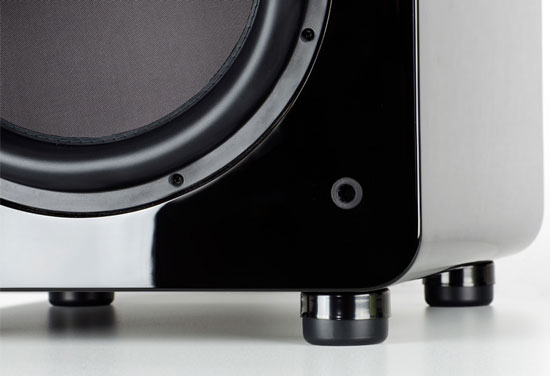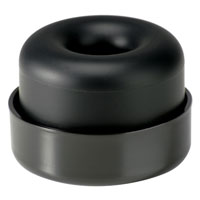If you're a home theater fan and you're also an apartment or townhouse dweller, odds are your neighbors are quietly plotting your murder. The fact is, sound travels. And like a crying baby on a cross-country flight, home theater sounds can be particularly difficult to contain for those who don't wish to hear them. This is especially true of that bone-rattling bass we all love so much. Unfortunately, in addition to our bones, that low frequency goodness tends to rattle walls, recessed lighting, and anything else it can find that isn't locked down tight. So yes, rest assured your neighbors are ready to kill you. But don't hire a bodyguard just yet. The bass experts at SVS have another solution.
The SoundPath Subwoofer Isolation System is a long and fancy name for what seems to be, at first glance, a very simple product: replacement feet for your subwoofer. Designed to work with any subwoofer which accepts screw-in feet - not just SVS brand subwoofers - the SoundPath system consists of four "optimized durometer elastomer feet which significantly reduce floor vibration." You can also purchase a set with six feet if you're using a larger subwoofer.
The SoundPath's chunky, rubbery feet essentially decouple the subwoofer from your floor. This takes away an easy exit strategy for low frequency sound, which in turn makes those things connected to your floor (e.g. your walls and your ceilings) less likely to shake, rattle, and roll. Or at least, that's the goal.

Yeah, But Do They Actually Work?
SVS was kind enough to send along a SoundPath review sample and I'm glad they did; perhaps like you, I was a bit skeptical. As luck would have it, I had the perfect test subject. Earlier this year, I swooned over SVS's SB13-Ultra compact subwoofer; in fact, I loved it so much I ended up buying the thing. I'm still using the SB13-Ultra in my reference theater, so the stage was set. Could the SoundPath feet make a great sub even better?
In the box, you'll find replacement feet for your subwoofer and several bags of machine screws of various common sizes. One of the bags is labeled "SVS cabinet subwoofers" so finding the right screws for my SB13-Ultra was a no-brainer. Before installing my sub's cozy new slippers, I wanted to first get a baseline using the stock subwoofer feet. For this, I turned to my trusty Avia Guide to Home Theater calibration DVD.
There are plenty of newer calibration discs out there, but Avia is still my fast and convenient go-to for performing a low frequency sweep on a subwoofer. This test gives your LFE channel a 100Hz tone which slowly moves lower until it bottoms out around 20Hz. If you have anything in your theater (or adjacent rooms) that's apt to rattle, vibrate, or hum when the going gets low, this test will find it.

In true scientific fashion, I next proceeded to change one and only one variable: the feet on my subwoofer. Using a phillips head screwdriver, installing the SoundPath feet took but a minute. Keeping my Emotiva pre/pro at the same volume, placing my subwoofer back in the same (low pile) carpet divets, and returning to the same seat on my sectional sofa, I re-ran my Avia test.
Drum Roll, Please...
With the SoundPath feet installed, my 50Hz rattle disappeared completely. The 29Hz hum was still there, but it moved lower, now starting around 21Hz and audible for just a very short time before the sweep ended at 20Hz. As before, I ran the LFE frequency sweep a total of three times. Amazingly enough, I was able to reproduce these new results all three times.
As a final test, I popped in my Blu-ray edition of Man of Steel, a bass-heavy film I've watched several times in recent weeks. It's not the cleanest bass test out there, but Man of Steel has a ridiculous amount of low-end grunt, particularly during the Supes-Kryptonians throwdown in downtown Smallville.
With the SoundPath feet installed, bass performance was subtly but noticeably improved. The SB13-Ultra is a fantastic subwoofer to start with, but with SoundPath, certain sequences sounded a tad less boomy and bass was slightly more precise. Most importantly, that 50Hz rattle - which I've become accustomed to hearing at times - was simply gone. Were these differences of the night and day variety? No. Am I the only who will notice them? Probably. But I'm perfectly OK with that.
For $50, the SoundPath Subwoofer Isolation System is a no-brainer. It's an easy and effective step towards making the most of your home theater. And unlike a lot of other room treatments and home theater upgrades, this one won't break the bank. It may not impress the friends and family, but rest assured the neighbors will love it.
Where to Buy: